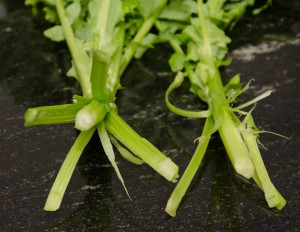I am writing a tribute to Gus and Carmel, owners of IL Fruttivendolo.

In 2009, I first wrote a post about Gus and Carmel Bressi’s enthralling seasonal, heirloom produce at the Queen Victoria Market on my blog, Sicilian Seafood Cooking. But my shopping at their vibrant stall began long before that.

When I moved from Adelaide to Melbourne in early 2002, I stumbled upon a hidden gem nestled in the QVM— a fruit and vegetable stall that felt like my own slice of Italy. I live just a stone’s throw away from the market and I found a profusion of seasonal delights that was reminiscent of my Italian background.
Gus and Carmel’s stall became my one destination for all things fresh. Here, I found a bounty of ingredients that were nearly impossible to find elsewhere in the QVM: the first cime di rapa, artichokes and cardoons (Carmel holding a cardoon).


Carmel was certainly very original and inspiring when displaying vegetables. Those brussels came from her.

Their shelves overflowed with fragrant herbs, crunchy fennel (both bulb and bunch), kohlrabi, and wild greens like nettles, milk thistle and amaranth that added adventurous variations to my cooking.
Endives, frisée and chicory were alongside bunches of puntarelle and senape – and I question if any shopper had seen this leafy green vegetable before (Senape is the middle photo).

There was an array of cauliflowers in every imaginable shape and colour and for many, much of the produce was uncommon. Above – Gus being enchanting to Mary Taylor Simeti who was visiting Melbourne from Sicily at the time. Although I had told him about her, when I introduced him to her, I dont think he realized just how much she knew!!! Mary is the queen of Sicilian Food writing. (Pomp and Sustanance, Bitter Almonds, Sicilian Summer – Cooking with my grandsons).

I marvelled at their diverse colours of eggplants, pink, white, violet and even striped eggplants, varieties that I had not seen since Sicily, crisp witlof of two different colours, and types of radicchio that I had not encountered since Trieste and Venice where radicchio reigns supreme (In the regions Friuli Venezia Giulia and the Veneto).

Fresh borlotti beans, broad beans, and the asparagus in colours and thicknesses, the thick white variety that was everywhere in Paris in Spring. The purple variety surprised me because it lost its colour when cooked.


And who could forget the first heirloom tomatoes, strikingly different carrots, and the sweetness of fresh figs and prickly pears?


While you might spot a few of these treasures at other stalls, Gus and Carmel were the true pioneers. Their passion for produce was profound, and they were more than happy to share tips on how to prepare even the most unfamiliar vegetables, turning every shopping trip into a culinary lesson. They were innovators, always one step ahead, knowing exactly what was in and who to source it from. Others, like John from Tomato City specialises in tomatoes, he does have eggplants, radicchio and artichokes, as Italian stallholders generally do, but Il Fruttivendolo specialised in the uncommon, a great range of varieties of the same vegetables, those not usually seen in other greengrocers.
Below, broadbeans. notice how relatively small they are. theis is how they should be sold, not like the briadbeans that are generally found in other places that are picked far too mature.

Their stall was filled with vibrant colour and fragrances and each vegetable, fruit and herb was meticulously labelled and beautifully arranged in baskets and boxes.

It was no wonder that their display often attracted the attention of photographers and TV crews, even if their contributions went unrecognized.
Gus and Carmel were initially located in B Shed, Stall 61-65, their space later transformed into the beloved Il Fruttivendolo—a name that elegantly summarises their dual role as sellers of both fruit and vegetables.

Il = the, frutti = fruit + vendolo = seller = fruitseller.
Just as greengrocers also sell fruit, fruit sellers also sell vegetables.

When the Queen Victoria Market underwent its redevelopment, they were relocated to a couple of temporary stalls before being housed in A Shed, where they continued to enthral customers.

Sadly, when I returned from a three-month trip away and I found that Il Fruttivendolo was no longer there. The operation of the stall came to an abrupt end early one morning when Carmel, alone and carefully organizing her produce, was threatened by an assailant at knife point. Fortunately, another stallholder intervened, chasing the assailant away. But the incident left its mark, prompting Gus and Carmel to accelerate their timing to retire.



Gus and Carmel Bressi were not just suppliers of fruits and vegetables; they were large contributors to the vibrancy of the Queen Victoria Market. Their absence is felt deeply by their customers and the other stall holders, especially those who just like Carmel and Gus have been there for a very long time.
They are remembered for their legacy, the flavours they brought to many kitchens, and their dedication and commitment to source quality produce.
There are many vegetable recipies in this blog – All Things Sicilian amd more.
Here are a few recipes, but if you use the search botton you will be able to find many more.
SENAPE, a new type of mustard green vegetable
NETTLES (Ortiche), Culinary uses and gnocchi
PASTA RIMESTATA COI CAVOFIORI; Pasta with cauliflower, sultanas, pine nuts and anchovies
FENNEL; male and female shapes
STUFFED BAKED FENNEL WITH PANGRATTATO; FINOCCHI RIPIENI
Melbourne; August: Winter Artichokes in risotto and stuffed
CAPONATA FROM PALERMO (made with eggplants)
MARY TAYLOR SIMETI and her new book:SICILIAN SUMMER An adventure in cooking with my grandsons
CARDOONS, What are they? (Cardoni or Cardi in Italian)
PASTA CON FINOCCHIO (Pasta and fennel; preferably wild). This is a recipe Gus gave me.
Below, a tribute from The Friends Of The Queen Victoria Market.
 .
.

















